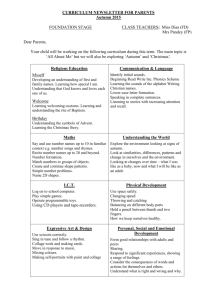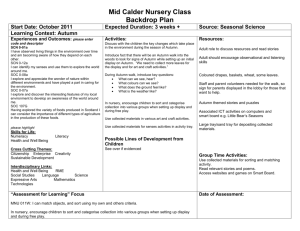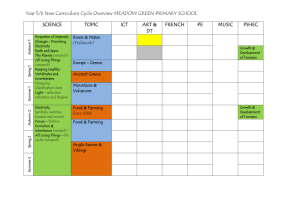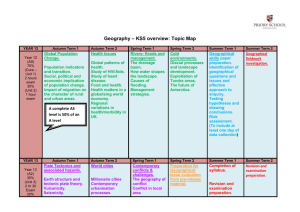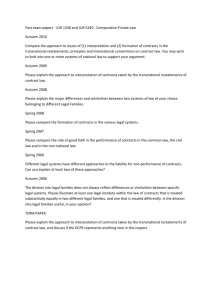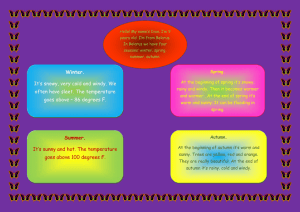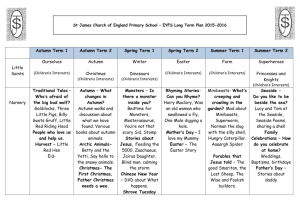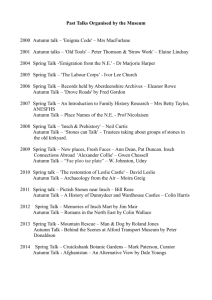Poetry Analysis Worksheet: "To Autumn" by John
advertisement
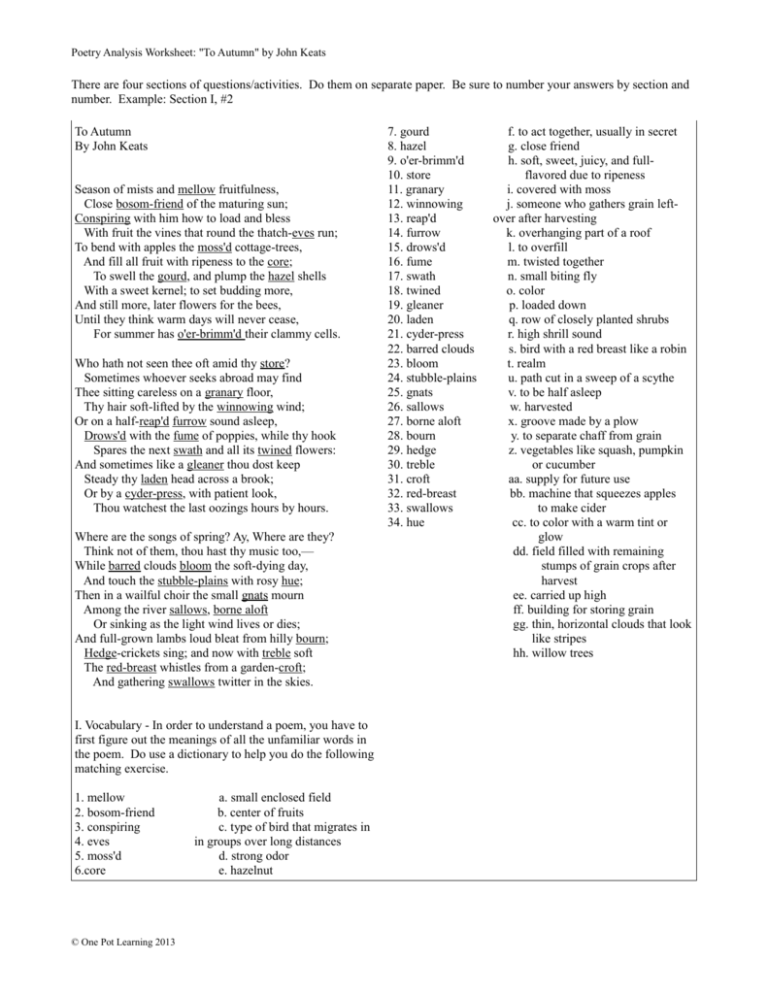
Poetry Analysis Worksheet: "To Autumn" by John Keats There are four sections of questions/activities. Do them on separate paper. Be sure to number your answers by section and number. Example: Section I, #2 To Autumn By John Keats Season of mists and mellow fruitfulness, Close bosom-friend of the maturing sun; Conspiring with him how to load and bless With fruit the vines that round the thatch-eves run; To bend with apples the moss'd cottage-trees, And fill all fruit with ripeness to the core; To swell the gourd, and plump the hazel shells With a sweet kernel; to set budding more, And still more, later flowers for the bees, Until they think warm days will never cease, For summer has o'er-brimm'd their clammy cells. Who hath not seen thee oft amid thy store? Sometimes whoever seeks abroad may find Thee sitting careless on a granary floor, Thy hair soft-lifted by the winnowing wind; Or on a half-reap'd furrow sound asleep, Drows'd with the fume of poppies, while thy hook Spares the next swath and all its twined flowers: And sometimes like a gleaner thou dost keep Steady thy laden head across a brook; Or by a cyder-press, with patient look, Thou watchest the last oozings hours by hours. Where are the songs of spring? Ay, Where are they? Think not of them, thou hast thy music too,— While barred clouds bloom the soft-dying day, And touch the stubble-plains with rosy hue; Then in a wailful choir the small gnats mourn Among the river sallows, borne aloft Or sinking as the light wind lives or dies; And full-grown lambs loud bleat from hilly bourn; Hedge-crickets sing; and now with treble soft The red-breast whistles from a garden-croft; And gathering swallows twitter in the skies. I. Vocabulary - In order to understand a poem, you have to first figure out the meanings of all the unfamiliar words in the poem. Do use a dictionary to help you do the following matching exercise. 1. mellow 2. bosom-friend 3. conspiring 4. eves 5. moss'd 6.core © One Pot Learning 2013 a. small enclosed field b. center of fruits c. type of bird that migrates in in groups over long distances d. strong odor e. hazelnut 7. gourd 8. hazel 9. o'er-brimm'd 10. store 11. granary 12. winnowing 13. reap'd 14. furrow 15. drows'd 16. fume 17. swath 18. twined 19. gleaner 20. laden 21. cyder-press 22. barred clouds 23. bloom 24. stubble-plains 25. gnats 26. sallows 27. borne aloft 28. bourn 29. hedge 30. treble 31. croft 32. red-breast 33. swallows 34. hue f. to act together, usually in secret g. close friend h. soft, sweet, juicy, and fullflavored due to ripeness i. covered with moss j. someone who gathers grain leftover after harvesting k. overhanging part of a roof l. to overfill m. twisted together n. small biting fly o. color p. loaded down q. row of closely planted shrubs r. high shrill sound s. bird with a red breast like a robin t. realm u. path cut in a sweep of a scythe v. to be half asleep w. harvested x. groove made by a plow y. to separate chaff from grain z. vegetables like squash, pumpkin or cucumber aa. supply for future use bb. machine that squeezes apples to make cider cc. to color with a warm tint or glow dd. field filled with remaining stumps of grain crops after harvest ee. carried up high ff. building for storing grain gg. thin, horizontal clouds that look like stripes hh. willow trees Poetry Analysis Worksheet: "To Autumn" by John Keats II. Literary Techniques 1. Alliteration is the repetition of beginning consonant sounds in nearby words. For example, in the first line you have the repetition of the m-sound in "mists and mellow." Find three more examples. 2. Sibilance is the hissing sound made in pronouncing certain words like the sounds at the beginning of these words: see, zoo, share, check, jet, and the zh-sound in revision. Find two more examples of visual imagery, one example of olfactory (smell) imagery, and two examples of sound imagery. 5. *Bonus Question*- Find the use of parallel structure in stanza 1. III. Meaning 1. True or false: In stanza 1 autumn works alone to bring about an abundant harvest. Write down the line(s) that supports your answer. Try to hear the sibilance in the first line of the poem: Season of mists and mellow fruitfulness, 2. In stanza 1, autumn performs a variety of tasks in nature. The first task would be: Autumn loads the vines with fruit. List all the other tasks autumn performs in stanza 1. Underline the sibilance in the next three lines: Close bosom-friend of the maturing sun; 3. True or false: In stanza 2, autumn steps up his activity and works even harder. Write down the lines that support your answer. To bend with apples the moss'd cottage-trees, To swell the gourd, and plump the hazel shells 4. In stanza 2, autumn is metaphorically compared to a farm laborer. List four things autumn could be found doing. The first one has been done for you as an example. 3. Personification is giving objects (or animals) human-like qualities. 1. Autumn could be found crossing a brook with a basket of gleanings on his head. ("And sometimes like a gleaner thou ... to set budding more, dost keep / Steady thy laden head across a brook") And still more, later flowers for the bees, Until they think warm days will never cease, 5. In the lines below In the lines above, the bees are being personified in that they have been given the human quality of thinking. while thy hook Spares the next swath and all its twined flowers: How is autumn personified in the second line of the first stanza? why does autumn spare the next swath of grain from being cut down? (Hint: read the preceding lines) Stanza 2 is full of personification of autumn. Find three examples and explain the personification. 6. In line 2 of stanza 3, the speaker tells autumn that autumn also has his own music. What five sounds make up the "music" of autumn? The first item has been listed for you. 1. the wailful choir of small gnats 4. Imagery is the use of vivid language corresponding to the senses - vision, smell, touch, taste, and sound. 7. In stanza 3, phrases such as "soft-dying day" suggest an ending or death to come and present a darker image of For summer has o'er-brimm'd their clammy cells. autumn. Find at least 3 other phrases that suggest this. In the above line, you have a visual image of the bees' honeycombs brimming over with honey. You also have tactile (touch) imagery of the clamminess of the cells (honeycombs). © One Pot Learning 2013 IV. Essay How is autumn characterized in each of the three stanzas? Is there a progression or development? What literary techniques are used to convey the various aspects of autumn? Poetry Analysis Worksheet: "To Autumn" by John Keats Answer Sheet I. Vocabulary 1. h 18. m 2. g 19. j 3. f 20. p 4. k 21. bb 5. i 22. gg 6. b 23. cc 7. z 24. dd 8. e 25. n 9. l 26. hh 10. aa 27. ee 11. ff 28. t 12. y 29. q 13. w 30. r 14. x 31. a 15. v 32. s 16. d 33. c 17. u 34. o II. Literary Techniques 1. him how; fill all fruit; winnowing wind; songs of spring; Think not of them, thou hast thy (among others) 2. Close bosom-friend of the maturing sun; To bend with apples the moss'd cottage-trees, To swell the gourd, and plump the hazel shells (Note that sibilance includes z-sound (as in zoo), j-sound (as in jeep), and ch-sound (as in check) as well as the various ssounds) 3. Autumn is personified by being given the human quality of having friends. (Reciprocally, the sun is also personified because it has autumn as its friend. Further in line 3, both are described as "conspiring," another human quality. The student only needs to identify the point in the first sentence of this answer.) "sitting careless on a granary floor" - autumn sits like a human "Thy hair soft-lifted by the winnowing wind" - autumn has hair like a human "Or on a half-reap'd furrow sound asleep" - autumn can sleep like a human "Drows'd with the fume of poppies, while thy hook" - autumn can be drowsy like a human "Spares the next swath and all its twined flowers:" - autumn can scythe like a farm laborer " keep / Steady thy laden head across a brook" - autumn can cross a brook with a basket on its head "Or by a cyder-press, with patient look, Thou watchest the last oozings hours by hours." - autumn can watch a cider-press making apple cider like a human (Any three of the above would be acceptable as answers.) 4. Visual imagery (any two of the examples below; there may be other possibilities) With fruit the vines that round the thatch-eves run; (1) To bend with apples the moss'd cottage-trees, (1) To swell the gourd, and plump the hazel shells (1) While barred clouds bloom the soft-dying day, (1) And touch the stubble-plains with rosy hue; (1) © One Pot Learning 2013 Poetry Analysis Worksheet: "To Autumn" by John Keats Olfactory (smell) imagery "Drows'd with the fume of poppies" Auditory (sound) imagery (any two from below) "Then in a wailful choir the small gnats mourn" (1) "And full-grown lambs loud bleat from hilly bourn; (1) Hedge-crickets sing (1); and now with treble soft The red-breast whistles from a garden-croft; (1) And gathering swallows twitter in the skies." (1) 5. *Bonus Question* Parallel structure is found in the repetition of the infinitive: "to load and bless...to bend with apples...to swell the gourd...to set budding more..." III. Meaning 1. False - Autumn works together with the sun to bring about an abundant harvest as seen in the lines: Close bosom-friend of the maturing sun; / Conspiring with him how to load and bless / With fruit the vines. 2. Autumn also (1) bends the apple tree with apples, in other words, makes the apple tree bear lots of fruit. (2) It ripens all the fruit. (3) It swells the gourds and plumps the hazel shells. (4) It sets more and more flowers to bud. 3. False - Autumn is shown to be rather inactive in stanza 2 as can be seen in the lines: (1) Sometimes whoever seeks abroad may find / Thee sitting careless on a granary floor,(2) Or on a half-reap'd furrow sound asleep,/ Drows'd with the fume of poppies (3) Or by a cyder-press, with patient look, / Thou watchest the last oozings hours by hours. (Any one of the lines above would be sufficient to support the answer.) 4. Sitting on the granary floor; sleeping on a furrow; watching apple cider ooze out of the cider-press 5. because autumn has fallen asleep due to the drowsing fumes of the poppies 6. bleating of the full-grown lambs; singing of the hedge-crickets; whistling of the red-breast; twittering of the swallows 7. "wailful choir"; "small gnats mourn"; "light wind lives or dies"; "And gathering swallows twitter in the skies" (this last one has to do with the fact that swallows gather to migrate south, which signals the coming winter) (Any 3 of the above phrases would be sufficient.) IV. Essay - Answers will, of course, vary. Students should be able to use the preparatory work done in sections I, II, and III and produce a coherent and well-supported essay that answers the topic questions. The essay should have a clear thesis in the introduction and organized body paragraphs that support the thesis as well as a brief conclusion. In the alternative, the teacher could just assign an abbreviated essay consisting of a thesis statement and 3 body paragraphs. © One Pot Learning 2013

